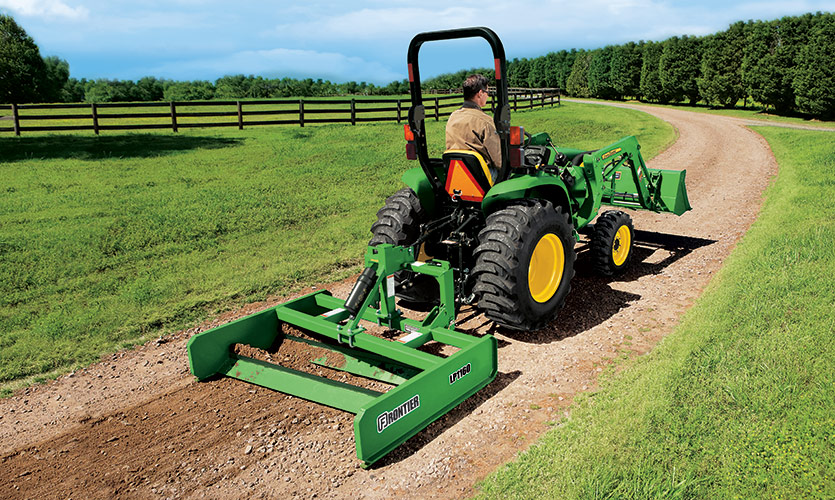It happens to the best of them. No matter how hard you work at it, how conscientious you are about maintaining it, repairing a gravel driveway is simply a fact of life. Potholes, washboards, gravel depletion, erosion. Over time, some or all of those problems will be yours to deal with. So here are some tips for dealing with these problems the right way.
Getting started.
Repairing a gravel driveway starts with getting the driveway surface as close to universally smooth and even as you can. If you have erosion, potholes, etc., you should use a box blade with scarifiers (US CA) or land plane with scarifiers (US CA) to break up the overall surface to a universal depth. With potholes, you really need to churn the driveway down to just below the bottom of the pothole, but not into the driveway’s foundation. (Yours does have a foundation, doesn’t it?).
Start by setting the sacrifiers to the desired depth. A couple inches deep will often suffice. Again, avoid digging into the driveway’s foundation. If you churn up anything half the size of your fist or larger, you’ve gone too deep.
Use the box blade or land plane to work over the entire surface of the driveway.
At this point, you’ll need to decide what size gravel you might need to apply. If your drive is soft and potentially muddy, you should consider putting down a layer of 1½-2½” (3.8-6.4 cm) crushed gravel. This will produce a good, stable layer that would provide good drainage, which will help prevent erosion. You might then top this with a good layer of ¾-inch (12 cm) minus gravel. This means the gravel will include everything from ¾-inch pieces all the way down to fines, or powder. This product will compact well, so you can create a firm, smooth surface.
Smooth things out.
Now, using a rear blade (US CA) set up perpendicular to your tractor and in its reversed position, smooth the drive’s entire new surface, allowing the blade to float along the ground. You should now have a good, firm surface to work with.
You could also use a land plane (US CA) instead of a rear blade to accomplish the same thing. When you’re on site and ready to work, with the land plane on the ground, set your 3-point in “float” position. Since the 3-point doesn’t exert any down pressure, your land plane will now float along the surface of the ground.
Beginning in the center of your drive, run the land plane over the surface. Gravel and other material will begin to accumulate in the interior of the land plane. As it fills, the gravel will begin to spread out evenly over the surface of the drive. Make several passes until you’ve covered the entire drive from edge to edge and created a smooth, even surface. Repairing a gravel driveway takes a bit of time, but if you do it right, keeping it in good shape will be a lot easier down the road.
And remember, always read the Operator’s Manual before operating any piece of equipment and follow all operating and safety instructions.
Frontier’s nearly 400 implements and attachments are designed, engineered, tested, and manufactured to fit and work with John Deere tractors. That’s a breadth and depth of John Deere and Frontier equipment compatibility you won’t find anywhere else in the world.
But we don’t stop there.
Beyond product performance, Frontier equipment is fully supported with John Deere warranty, service, parts, and customer support throughout our North America John Deere dealer network.
Whether it’s your land, your job, or your life, experience the fun and true satisfaction you’re looking for. You, John Deere and Frontier. Let’s work together.
Helpful Links:
Frontier Landscape Equipment (US CA)
How to use a box blade. The basics.
How to maintain a gravel driveway.
How to maintain a gravel drive using a box blade with hydraulic scarifiers


